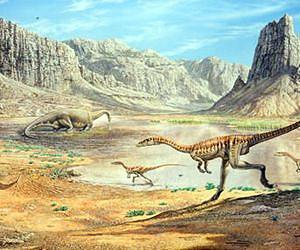 |
| An artist's impression of a middle Triassic landscape |
It was originally thought that it took around 15 to 30 million years for the terrestrial biota to recover. However compelling new evidence compiled by Professor David Fastovsky and undergraduate student David Tarailo from the University of Rhode Island, suggests that life got back on its feet in just 5 million years. In a presentation at the annual meeting of the Geological Society of America in Minneapolis, they outlined their theory which challenges the theory that land and the oceans were affected equally by a series of global events.
Their data comprised a comparison between the comprehensive lists of fauna from two fossil localities: the middle Triassic Moenkopi Formation in Arizona and the nearby, late Triassic Chinle Formation. If the terrestrial biota took up to 30 million year to recover, there should be a great difference in the diversity at both sites. Instead, Fastovsky and Tarailo found that they were quite similar. 'Our results suggest that the cause of the extinction didn't spill over as severely into the terrestrial realm as others have claimed,' said Fastovsky.
'There was still a terrestrial extinction, but its repercussions weren't more long term than those in the marine realm, and possibly less.' A problem arises with this otherwise interesting idea in that the two formations represent only one point in North America. At this time all the continents were still part of the single landmass of Pangaea, which removes all oceanic barriers. Similarly, there would have been fewer geographical differences due to a very similar global climate.
'Some may argue that our results are just one data point in North America, but if North America is representative of the rest of the world, then our results apply to the entire world.' To provide more evidence to support their theory, the team have said that they are going to expand their fossil analysis to worldwide localities.